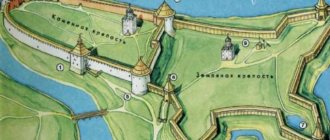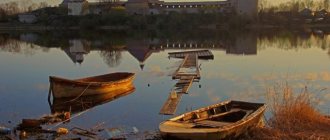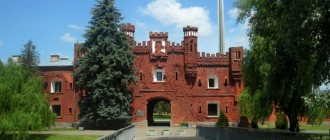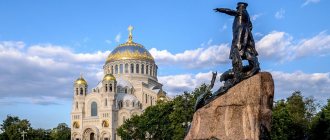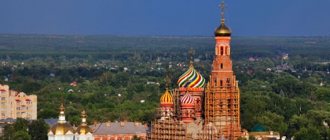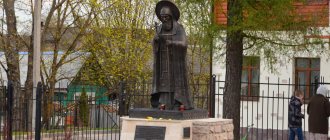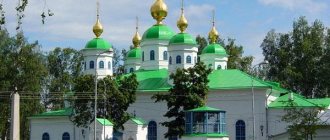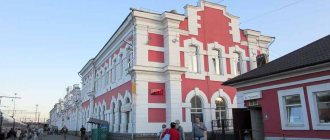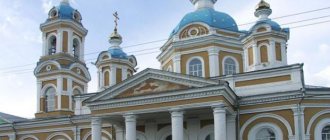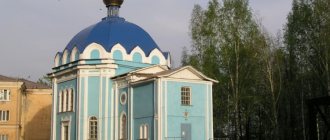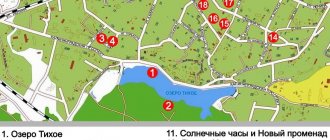Museum-Reserve "Staraya Ladoga" (Staraya Ladoga, Russia) - exhibitions, opening hours, address, phone numbers, official website.
- May tours
to Russia - Last minute tours
to Russia
1/
10
Church of St. George, Staraya Ladoga Wikipedia.org- Fortress in Staraya Ladoga, entrance through the Gate Tower
The Staraya Ladoga Historical and Architectural Museum-Reserve “Staraya Ladoga” includes an earthen fortification, stone fortress walls and towers, the Church of St. George, and the wooden church of St. Dmitry of Thessalonica. Archaeologists believe that the oldest buildings date back to the 8th century AD. e. The earthen fortress was built by Prince Rurik before his move to Veliky Novgorod, and subsequently it was constantly strengthened and expanded.
Battle towers on the old earthen ramparts of the Rurik settlement at the confluence of the Ladozhka River (now Elena) with the Volkhov became a serious outpost on the way to Novgorod. In 1164, the Swedish army besieged the fortress, but was unable to take it. In memory of this, the Church of St. George the Victorious was erected. The wooden church of Dmitry Solunsky is a most valuable monument of Russian architecture of the 17th century. The museum's holdings include 132 thousand artifacts, the most valuable being the Neolithic and archaeological collections, fragments of frescoes from the destroyed Church of the Assumption of the 12th century.
Foundation of the museum
The Staraya Ladoga Museum was founded in August 1966, but received its first visitors five years later - in July 1971. Nowadays, the territory of the ancient city and its surroundings has been given the status of a historical, architectural and archaeological museum-reserve. The museum collections contain more than two hundred thousand different exhibits, including many fragments of destroyed murals. Museum exhibitions can be found not only directly in the halls of the museum building, but also in many monuments of ancient Russian architecture.
The archaeological collection of the Staraya Ladoga Museum-Reserve is rightfully considered one of the most interesting in Russia; exhibits from the museum collection have visited many European cities. From the very beginning of its foundation, the Staraya Ladoga Museum became the custodian of exhibits that were found as a result of archaeological excavations of the Staraya Ladoga expedition. The basis of the archaeological collection consists of objects that were extracted from cultural layers and funerary monuments of Staraya Ladoga, dating back to various eras. These include items made from various materials: iron, bronze, lead, glass. A number of finds that were discovered in the “wet” cultural layer are considered quite valuable - in soil that was well saturated with moisture, and therefore the objects found in it did not undergo such a strong decay process due to the low influx of oxygen. These are mainly exhibits made of organic materials - wood, leather, bone, horn and woven objects.
Museum exhibit
Practical information
Address: Staraya Ladoga, Volkhovsky pr-d, 19. Website.
How to get there: by car along the E105 St. Petersburg - Petrozavodsk highway. By train from the Moscow or Ladozhsky train stations in St. Petersburg to the Volkhovstroy station, from there by bus to Staraya Ladoga.
Opening hours: from June 1 to August 31 on Mondays - from 9:00 to 17:00, Tuesday-Sunday from 9:00 to 18:00. A single ticket for adults to all museum objects is 200 RUB, for pensioners, students and disabled people - 100 RUB, for children under 16 years old - free. Prices on the page are for February 2022.
Museum exhibits
Some exhibits that date back to an earlier period than the medieval ones are also kept in the museum collections of the archaeological department. These are several exhibits made in the Stone Age and the Early Metal Age, which ended up in the museum’s fund along with the collection of A.A. Inostrantseva. A professor at the St. Petersburg University of Foreigners, he carried out archaeological work in the southern Ladoga region in the 19th century. Currently, the Staraya Ladoga Museum-Reserve receives for storage exhibits from archaeological expeditions operating almost throughout the entire territory of the Leningrad Region.
Museum exhibit
In the ethnographic exhibition of the museum, visitors can get acquainted with the clothing of the peasant, petty bourgeois, noble and merchant classes, as well as get an idea of the everyday side of life of the inhabitants of Ladoga.
Exhibits from the everyday life of Ladoga residents
The main profitable trades with the help of which Ladoga residents obtained their “daily bread” were: forestry, shipping, fishing, tanning, farriery, blacksmithing, and slab-breaking. The presence in the exhibition of numerous spinning wheels - “gilded” and “dyed” - is clear evidence that among the female population such crafts as spinning and weaving were widely developed.
The tradition of collecting picturesque works of art originated in Staraya Ladoga in the first half of the 19th century. Alexey Romanovich Tomilov, in his Uspenskoye estate, which was located in the center of Staraya Ladoga, collected a rich collection of works by many famous artists. Unfortunately, in 1924, the collection of the Tomilov-Shvartsev family, which included etchings by Rembrandt and paintings by Kiprensky, Aivazovsky, Kustodiev, Roerich and others, was taken out and transferred to the exhibitions of the Hermitage and the Russian Museum.
After the museum was opened in Staraya Ladoga, collecting traditions were revived. The museum's exhibition, which is dedicated to paintings, contains more than four hundred works. Basically, works here belong to Russian and Soviet artists who worked in different years on the picturesque lands of Staraya Ladoga and its environs: V. Vilner, L. Kostenko, S. Chepik, T. Kozmina, the Bazhenov family and many other masters. The themes of the paintings are dominated by architectural and natural landscapes, still lifes, and also reflect the modern life of Ladoga residents.
A picture about the modern life of Ladoga residents
The Staraya Ladoga Museum-Reserve presents ten sightseeing and thematic excursions, which include both excursions around the museum’s expositions and exhibitions, as well as excursions around the architectural monuments and monasteries that are part of the museum complex. Tours are conducted in Russian and several foreign languages.
Museum-Reserve "Old Ladoga"
The scientific and educational department of the Staraya Ladoga Museum-Reserve is developing various programs for schoolchildren and students in the historical and cultural field. The annual historical and folklore festival “Wreath of Glory” is held on the territory of the museum on the second Sunday of July. The Church of St. George is the place where folk groups and classical musicians hold their concerts. And visitors to the museum-reserve can see the unique beauty of the Ladoga panorama from Malysheva Mountain.
Architectural sights of Staraya Ladoga
Fortresses
- The Staraya Ladoga fortress was first built of wood in the 9th century and performed defensive functions from the Baltic Sea. The stone fortress was built in the 12th century and was completed and rebuilt several times. The fortress itself is located in the center of the village and is its “heart”. The Staraya Ladoga fortress was built at the confluence of the Ladozhka River and the Volkhov, which complemented its defensive capabilities.
The fortress was repeatedly attacked, destroyed, and sieged, which is why buildings dating back to the 16th century have survived to this day. Of its five towers, only two have been preserved and reconstructed, Klimentovskaya and Vorotnaya; in some places the thickness of the walls ranges from 5 to 7 meters. The Rolling, Switch and Secret towers lie in ruins.
On the territory of the fortress there is a church and a cathedral. The fortress lost its defensive functions and strategic importance at the beginning of the 18th century, after the conquest of Noteburg. Now you can visit the fortress any day, and in the summer festivals and holidays are held on its territory.
- The Lyubsha fortress was discovered not so long ago. Historians began studying it at the end of the 20th century. The Lyubsha fortress is the oldest stone structure, which, unfortunately, has not survived. In the 8th century it was a large trading center located not far from the border, but in the 9th century the village was abandoned.
Now all that remains of the fortress are two-meter-high ruins and ramparts, and the area around the fortress is overgrown, so it cannot be immediately seen. However, there is beautiful nature here, which, together with the fortress, is depicted by the famous artist Nicholas Roerich in his painting “Overseas Guests”.
- The earthen settlement is located in the south of the Staraya Ladoga fortress, surrounded by wooden and earthen ramparts dating back to the 16th century. The Zemlyanoye settlement and the Staraya Ladoga fortress were the main defensive structures until the eighteenth century.
Currently, archaeological excavations are being carried out on the territory of the settlement; many artifacts and household items from the 8th to 11th centuries, which are of European and Arab origin, have been found. You can visit the ancient building and attend the excavations, immersing yourself in the spirit of that time.
- The stone chapel was built in 1913 by the architect N. Brandenburg, on the site of the Spassky Church. The initiator of the construction was the Imperial Geographical Society, which decided to build a shrine on the site of the previous one, which had not survived.
- Houses of the Kolyazin merchants . In one of the houses, a wooden one, there is a museum “Merchant Life of Staraya Ladoga”, which displays household items, dishes, clothes of merchants and peasants of the 19th -20th centuries. Where you can see how merchants of that time lived.
In the stone house of the Kolyazins there is an archaeological museum, which displays exhibits of ancient Ladoga, because excavations on this territory have been carried out since the 19th century.
Historical sights of Staraya Ladoga
- The Uspenskoe estate is adjacent to the Assumption Monastery. The estate was erected by Lieutenant General R.N. Tomilin and was rebuilt by his son. Tomilin was a connoisseur of art; famous artists such as Aivazovsky, Roerich, Kiprensky, Venetsianov often visited his house. And in his house there was a collection of paintings by these and other famous artists. After the revolution, the estate was confiscated, and the collection of 6,000 paintings and objects was transferred to the St. Petersburg Museum, among which were paintings by Rembrandt.
Now the estate is in an abandoned state and the entrance to the building is closed, but many tourists and local residents love to stroll along the alleys and parks of this estate.
- The Museum of the Staraya Ladoga Fortress is located in the Gate Tower of the Staraya Ladoga Fortress on the second and third tiers. The museum includes all churches, buildings, mounds and other structures located in Staraya Ladoga. Separately presented are exhibits in the form of household items, dishes, weapons, and armor from the Middle Ages, discovered in this area by archaeologists.
In the summer, on the territory of Staraya Ladoga, an annual thematic festival “The First Capital of Rus'” is held, where everyone can try on chain mail, local residents prepare ancient recipes, battles are held with the help of ancient weapons. Anyone can attend this wonderful event and plunge into the Middle Ages.
- Varyazhskaya Street is the oldest street of ancient Russia. A walk along this street is a tradition for all tourists. Now there are modern buildings on the street, but archaeologists and historians still find objects from the 9th-10th centuries on this street, which has made it popular. It is on this street that there is a Stone Chapel, built in 1913, on the site where the Spasky Church stood, destroyed by time. Along Varyazhskaya Street there are houses of the Kalyazin merchants and the famous Falcon sculpture.
- The mounds do not look like anything special, but it is worth realizing that these mounds date back to the 8th-9th centuries, which makes them special. In total, there are three burial mounds in Sopki - these are ancient burial places. According to one theory of historians, one of the mounds is the burial place of Prince Oleg. The mounds have artificially and naturally created catacombs, but there is no way to get into them. The mounds are easy to climb and offer amazing views of the Volkhov River.
- Oleg’s grave is one of the oldest burial sites in Russia, so many tourists visit the mounds every day. There is an opinion that the energy of these places has healing properties. Having visited these parts, be sure to visit the mounds dating back to the 8th-9th century. However, be careful when going up and down the hills, as they are flanked on one side by a gentle slope down to the river.
- The caves in Staraya Ladoga were created in the 19th century by people who mined white quartz sandstone here, which was used in the glass industry. There are several caves here, the most famous of which are Staroladozhskaya, Tanechkina, and Malyshka. The length of some caves reaches 7.5 km, some passages in the caves are blocked, so it is better to visit the cave not alone, but as part of an excursion group, so as not to get lost.
In the Tanechkenaya Cave there is an underground lake that practically never dries out, and patterns from various rocks are visible on the walls. A large number of bats hibernate in the cave. It is safe to visit the caves under the guidance of an experienced guide and wearing comfortable shoes, since many passages in the caves are blocked and flooded.
- The Pobedishche tract is located on the southern outskirts of the village of Staraya Ladoga, the discoverer of which was the geographer N.E. Branderbug. The remains of people, horses, and weapons were discovered here.
According to legend, it was here that a major battle with the Swedes took place, in which many warriors died, whose blood flowed down the stream into the waters of the Volkhov River. Not far from the tract flows this stream, which is called “Bloody”.
- The Sopki tract is a cluster of mounds in the form of ancient burials. There is still controversy over the most famous burial - Oleg's grave, which has been studied since the 19th century; one of the archaeologists found human remains, but evidence of authenticity is still in doubt.
- The Lyubshan settlement was discovered in 1997 and is considered the oldest structure, dating back to the 7th century. However, according to research, the fortress was abandoned in the 9th century, as it lost its defensive significance for the Slavs.
- Gorchakovshchinsky waterfall is located near the village. Its peculiarity is that it is the highest waterfall in the entire Leningrad region, its height is 4 meters. It is located on a small river flowing into the Volkhov. The waterfall is surrounded by greenery and picturesque terrain; you can find it with the help of local residents or on your own.
Shrines of Staraya Ladoga
On the territory of the small village of Staraya Ladoga there is a large number of churches, temples, and monasteries. This is due to the fact that Staraya Ladoga is considered the first capital of Rus', which makes them unique, let's look at some of them:
- The St. Nicholas Monastery on its territory has the Church of St. Nicholas, the Church of St. John Chrysostom, a bell tower and a number of monastery buildings. The founder of the monastery was Alexander Nevsky in 1240, after the victory over the Swedes.
In 1611, the monastery was almost completely destroyed by the Swedes, after which it was rebuilt. The building of the monastery has had a difficult history. In the 17th century, Valaam monks moved here after the destruction of their monastery by the Swedes. In 1927, the monastery was closed; during Soviet times, a school, a dormitory and a warehouse for agricultural equipment were located on the territory of the monastery.
In 1974, the St. Nicholas Monastery was recognized as a historical monument of national significance. Reconstruction work there is still underway. The main attraction of the Nikolsky Monastery is that a particle of the relics of St. Nicholas the Wonderworker .
- Holy Dormition Monastery and Assumption Church . The Assumption Church was built in 1156, and is one of the oldest buildings in Staraya Ladoga; the remaining buildings adjacent to the monastery were erected in the 19th century.
The Assumption Monastery was originally a men's monastery, but was later transferred to nuns. The monastery was famous for the fact that at different times famous women, such as Evdokia Fedorovna Lopukhina, wife of Peter 1, Evdokia Hannibal, were imprisoned on its territory. During the imprisonment of the wife of Peter 1, the tonsure of new nuns was stopped, parishioners were prohibited from entering the monastery territory, and a military guard was on duty. Later, relatives of the Decembrists were exiled here.
The temple building dates back to the pre-Mongol period and has a large number of frescoes that are not very well preserved.
On the territory of the monastery there is the Church of the Exaltation of the Cross, where the relics of saints are kept, which significantly increases the flow of tourists and pilgrims.
- The Church of the Nativity of John the Baptist was built in 1695 on Malysheva Hill. There was previously a monastery here, dating back to the 13th century, but one stone building has survived.
At the beginning of the 20th century, the church began to sag due to voids and caves in the mountain, formed as a result of the extraction of quartz sand by local residents. After which it was necessary to save the temple from destruction by filling the voids with concrete. In the temple there is the limit of St. Paraskeva Pyatnitsa, and not far from the temple, the spring of St. Paraskeva Pyatnitsa flows, the water in which is healing.
- The Church of St. George is located on the territory of the Staraya Ladoga fortress, in which frescoes from the 12th century have been preserved. According to legend, it was in this temple that Alexander Nevsky prayed and illuminated his sword before the battle with the Swedes.
The construction of the temple dates back to the 12th century, and is considered one of two shrines that have survived to this day. Unique, preserved frescoes decorate the walls of the temple. One of the most famous is considered to be the image of St. George the Victorious on a horse, who steps on a snake; it is called “The Miracle of St. George on the Snake.” The second known image on the drum dome is “The Ascension of the Lord.”
Currently, there are no worship or services in the temple, but it is open to tourists and local residents.
- The Church of Dmitry of Thessalonica was built in the 17th century on the territory of the fortress at the Church of St. George the Victorious; the church itself was dismantled and rebuilt several times. A copy dating from the 20th century has survived to this day. The Church now houses a local history museum, where you can get acquainted with the history of the temple and objects of peasant life.
- The Church of Alexei, Man of God was built of wood in the nineteenth century with donations from local residents as a small chapel. Over time, local businessman Semyon Kalinin allocated money for the construction of a stone church. The church underwent a complete restoration in 2000.
- The Transfiguration Church was built on the banks of the Volkhov River from wood in the 17th century, but it could not survive the fire. A new stone church was erected in its place in 1871 with donations from the merchant Rybin, and has survived to the present day.
- The churchyard and Church of St. Basil of Caesarea were here back in 1618, but the building was completely destroyed by the end of the century. Several decades later, a new stone temple was erected at the expense of the local governor. Not long ago, the temple underwent another restoration and is now open to the public.
Monuments and memorials of Staraya Ladoga
- The monument to Rurik and the Prophetic Oleg was unveiled along Varyazhskaya Street, personifying the beginning of the revival of Russian statehood. It is unique because it exists in a single copy in all of Russia.
- The stele in memory of the 1250th anniversary of Staraya Ladoga is located next to the cultural and sports building, personifying the long existence of the village.
- The Falcon sculpture is located at the beginning of Varyazhskaya Street and is symbolic for local residents. It is this bird that is depicted on the coat of arms of Staraya Ladoga and represents the unity of people and nature. There is a tradition of placing a coin between the feathers of this bird for good luck.
Architectural monuments
There are many architectural monuments in the village that the villagers take care of. It is impossible to tell about everyone. We present some of them.
Barracks of the Suzdal Regiment
The second half of the 18th century was marked by numerous peasant riots. Staraya Ladoga did not escape the same fate. To pacify the rebels, the Suzdal Infantry Regiment, commanded by Suvorov, was transferred.
The barracks appeared at the beginning of the 18th century, when Peter the Great ordered the construction of a canal here to bypass Lake Ladoga during storms. Workers lived in the buildings
At first the soldiers were housed in private houses. Controlling a scattered army was difficult.
Suvorov initiated the construction of barracks with all the necessary buildings.
In addition to the premises for soldiers, on the same territory there are:
- stable;
- infirmary;
- officers' club;
- parade ground with a shooting range;
- wooden temple.
Currently, the barracks are dilapidated, but a memorial plaque in which Suvorov is noted is on the wall.
Take note: the monument to the Barracks of the Suzdal Regiment is located on Proletarsky Kanal Street, building 12.
If a tourist arrives by bus, it will take a quarter of an hour to reach the barracks. You need to go towards the exit from the village, cross the canal and turn left. The ancient monument will be on the right.
Gostiny Dvor building
There is no exact date for the construction of Gostiny Dvor, but historians suggest that it was built in the 19th century. Going inside, you can see a quadrangular square. Along the walls there are benches where merchants once sat.
It has a standard layout, typical for buildings of this type: a quadrangle with an area inside, along the perimeter of which there are merchant shops, separated from the street by an arcade. The building was probably built in the 19th century
The house is located in Novaya Ladoga, 11 kilometers from Staraya. Between Karl Marx Avenue and Pionerskaya Street.
Defensive structures
The settlement served not only as a junction of sea routes. It was located on the border with other states, so it had another important role - the defense of the borders of Rus' from enemy attacks. It is clear that it would not have been possible without the construction of reliable fortresses with thick walls.
The walls, made of flagstone and lime mortar, reached a height of 8 meters. The Ladoga stone fortress outlined the path in defensive architecture that became widespread only a century later. It turned out to be invulnerable to the Swedes and Germans, and throughout the 12th-15th centuries it reliably protected the northern Russian lands.
Unfortunately, many of the fortresses have sunk into oblivion, and even no memories remain of them. But travelers can visit a unique place, imagine themselves in the place of their ancestors who defended the city of Staraya Ladoga by visiting the Staraya Ladoga Fortress.
Ancient Staraya Ladoga fortress
On the opposite side of Varangskaya Street is the Staraya Ladoga Fortress. In ancient times, it reliably protected the settlement. The stone part of it came close to the water. The presence of the river, which served as a natural moat, did not allow the Vikings to get close to the Slavs unnoticed.
Staraya Ladoga Fortress - located in the village of Staraya Ladoga on Cape Ladoga, at the confluence of the Ladozhka River with the Volkhov
This is interesting: part of the walls of the Staraya Ladoga fortress, the most vulnerable places, are 12 meters thick.
The view was carried out from four round and one square towers (the gate to the fortress). Three walls were made of wood, but the earthworks were strong. Residents always stocked up on food and water, so the defenders could hold out for a long time.
The stone fortress was founded in 1116 by order of mayor Pavel. Today she found herself in the center of the village at the confluence of the Elena and Volkhov rivers. In ancient times, it was a safe harbor for ships that could not pass through the destructive rapids of the Volkhov River. They began to strengthen the fortress by order of Prince Oleg.
Today, anyone can freely visit the fortress. The standard entrance fee to the fortress territory is 20 rubles, a single ticket to all museums is 150 rubles.
Where did the name come from
No one can say for sure what the name of the settlement was. After all, other geographical objects are called exactly the same: river, lake. They got their name before the settlement appeared.
Staraya Ladoga is the oldest trade and craft settlement in the North-West. People lived here during the Neolithic period, but the official date given by archaeologists is 753
There are many variations of the name. In short, some researchers believe that the word is of Scandinavian origin, because the Scandinavians were the first to explore this place, almost two decades before the Slavs. If we judge based on this fact, then the word is translated as a low area near a river.
Russians began to settle here in the middle of the 13th century. The settlement played an important role: the main hub connecting trade sea routes. Moreover, Staraya Ladoga was at one time the first capital city of Rus'. Rurik reigned in it. That is why a trident in the form of a diving golden falcon was placed on the flag of the Staraya Ladoga rural settlement - the sign of the Rurikovichs. During the excavations, a scroll made of birch bark was found, on which a boat was depicted. Who knows, maybe this sea transport is the symbol that gave the name to the settlement.
If suddenly you didn’t already know, then we recommend reading the article about how many towers the Moscow Kremlin has and what they are called.
